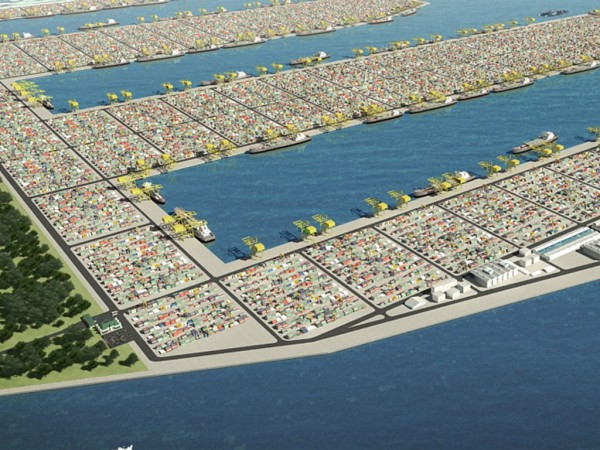Port operations reach new highs
Drones to deliver for port authorities
Earlier this month the Maritime and Port Authority of Singapore (MPA) signed an agreement with Wilhelmsen Ship Services (WSS) and Airbus to develop an unmanned air system (UAS) to assist in various port and ship operations. The initial pilot program scheduled for Q-3-18 is aimed at the delivery of spare parts, documents and parcels to vessels anchored within the harbor. Andrew Tan, MPA’s Chief Executive Officer, said “MPA will provide a suitable test-bed in the Port of Singapore for both companies to test their systems at sea and enable us to develop the regulatory framework for drone deliveries. The use of such innovative technology could help improve productivity and free up manpower and resources that could be deployed for other value-added jobs.”
Airbus recently concluded an initial test of their unmanned system delivering parcels between two stations within the port. The new joint service called Agency by Air will now perform extensive tests of port to ship deliveries. The first phase will be a two-week trial involving a series of drops to ships anchored a mile and a half off the port’s eastern anchorage. Two control stations will be set up quayside with an additional location at Marina South, Marina Bay Singapore. Designed for parcel delivery in dense urban areas, the Airbus Skyways drone was initially tested in and around National University of Singapore earlier this year. It will be adapted for heavy load use in the initial offshore trials.
Wilhelmsen takes to the air
WSS has put the full weight of their development team behind UAS technology as part of their ship chandlery operation. They believe drones would significantly cut delivery time and cost allowing for more productive scheduling of services. Unmanned air ships could, one day, significantly reduce the use of crews for water borne deliveries. Wilhelmsen is currently evaluating drones for use both at sea and on inland waterways. Marius Johansen, VP of Business Solutions, acknowledged that with today’s technology, drones are capable of carrying heavy payloads. While currently confined to shore side operations, Johansen envisions drones hauling payloads of up to 1,700 lbs, supplying parts to ships at sea. Wilhelmsen operates in over 2,000 ports in 125 countries worldwide; the potential for expanding the integration of port operations and related services is immense. A drone delivery service could conceivably be 90% cheaper than using launch boats, Johansen said.

Ports of the Future Today
Singapore unveiled its vision of the future at their ‘Intelligent Port of the Future’ Exhibit this January, showcasing everything from unmanned delivery to drone based surveillance. Drones will also allow port engineers to perform inspections at a safer distance. With the use of “Augmented Reality”, engineers using smart goggles can visualize port equipment in a whole new way. Design flaws and stress related wear and tear can be seen and documented without the need for physical inspection. Amphibious units could be employed to examine wharfs and side fenders, eliminating the need for divers to perform routine tasks, freeing them for more precise work.
Singapore began envisioning their “automated port” as far back as 2015. In a speech given to the Singapore Maritime Institute, Mr. Andrew Tan outlined “The Next Generation Port 2030”. In his remarks, Tan noted that the continued consolidation of mega carriers and mega alliances made it impossible for Singapore to service their carriers in conventional ways. As a crossroad between Southeast Asia and the world, the MPA would build a mega port which could safely and efficiently bring capacity from 40 million TEUs to well over 60 million units.
The Tusa Mega Port
Singapore is the world’s busiest transshipment port, receiving 54,120 cargo ship calls last year. In order to handle the anticipated growth over the next 22 years, the MPA has adopted a construction plan worth 1.46 billion Singapore Dollars ($1.07 billion). The creation of a mega port in the Tusa basin will reclaim 387 hectares of land capable of handling 65 million containers by the year 2040. Phase one scheduled to be completed in early 2019 will continue Singapore’s trend setting use of innovative technology. In the words of Andrew Tan, “We cannot just deliver world-class service to shipping lines in isolation. To stay relevant over the next 10, 20, 30, or even 50 years, we need to deliver world-class service to all our customers – which is why we have put in place the Next Generation Port 2030 initiative…As a vision and goal, the NGP 2030 will allow us to utilize a new generation of technologies to increase efficiency and productivity, intensify land-use in the port, improve safety and security, raise the level of sustainability …”

Along for the Ride
We are entering a new era of port development. When it comes to technological innovation, ports today can no longer simply go along for the ride. Those who do not innovate are doomed to fall by the wayside. As transportation professionals, we need to confront our regional ports. We need to continue asking them, “What are you doing to stay ahead of the pack?”
© Copyright 1999–2024 American Journal of Transportation. All Rights Reserved

